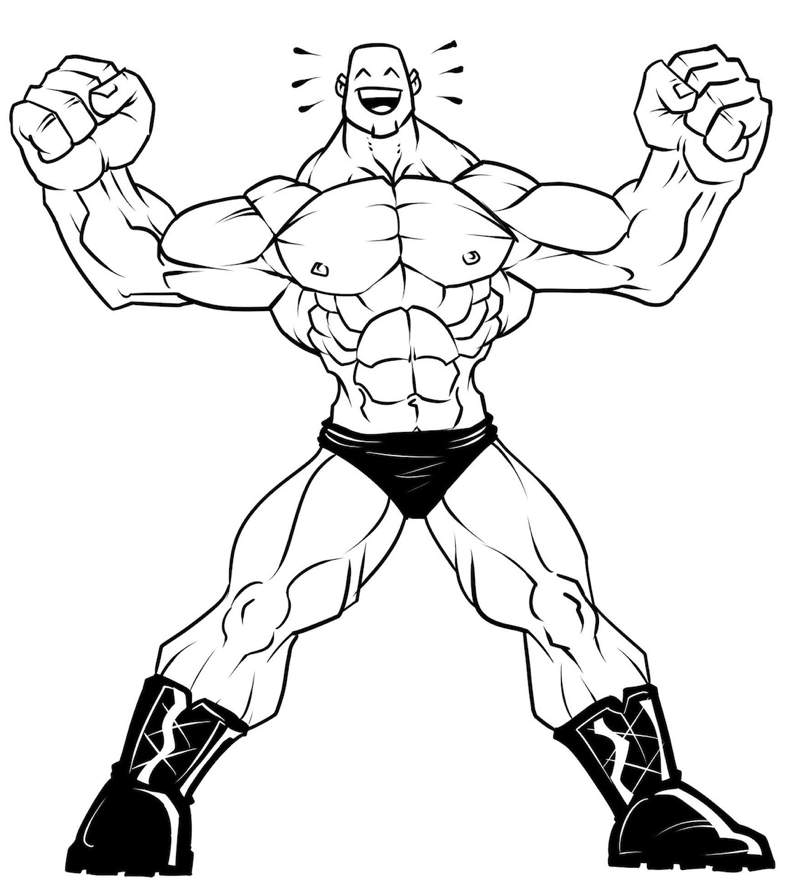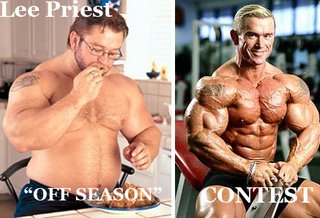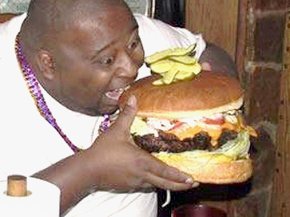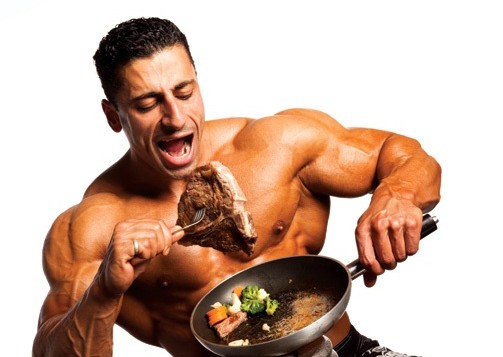Now that we’ve given you everything you need know about « cutting », we will explain how to put on lean mass.
Part 1 – Presentation
Part 2- The “Lean Mass” Cycle Length
Part 3 – Lean Mass and The After.

Part 1- Presentation
What is this « lean mass » concept about?
Usually, a «bulk » focuses on a hypercaloric diet (from 3000 to 5000 calories for some!). The « lean mass » approach is more moderated, as caloric intakes will not stray as far from your maintenance (from 150 to 300 calories). This process still ensures an anabolic environment, which allows muscle to build, but limits fat gains. In other words, by using this more controlled approach, fat is gained at a slower rate.
The “lean mass” approach focuses on a controlled diet, as opposed to “bulking” which often rhymes with gluttony. Not only does bulking leave a person with a high-level of body fat and stretch marks, they are also often left with bad eating habits and a loss of self control.
Without a proper diet post-bulk as well as a good understanding of your body, losing the extra accumulated body fat is difficult to do. There is also another thing about “bulking”, which has been made popular by the pro-bodybuilding scene. These bodybuilders have more than just a genetic advantage, they also have a pharmaceutical advantage (which is a huge one). Lee Priest is a good example:

Some drugs, either anabolic compounds or ATP inhibitors, lead to greater weight loss as they have an important lipolytic potential. This is the reason why bodybuilders don’t hesitate to gorge themselves during a bulk, as they know they will be able to lose the weight afterwards.
But, for people who don’t use such substances, the situation is much different, and so “bulking” is not the best choice in many cases.
Wanting to put on some mass should not be an excuse to have bad dieting habits, binge, and become diabetic.

My opinion on the subject is that fitness is a journey, a lifestyle-changing voyage that should encompass all aspects of your life. Looking and feeling good could be part of it all year round. “Bulking” is a call for diet laziness, and fat can snowball on you, because well…no amount of food is enough once you’ve started. Focusing on gaining “lean mass” on the other hand, leads you to become bigger, stronger…and the sailor moves forward 🙂
For muscles to grow, the body needs energy- to be more precise, nutrients that will act as the building blocks for this process. Gaining muscle either means creating new muscle fibers, or reinforcing existing ones. Resistance training or endurance training have a direct impact on these fibers, and this is the kind of impact that will drive muscle synthesis.
Bodybuilding is a sport that focuses on resistance, and the repetition of this resistance (which is the contractile elements action) leads to the development of the muscle engaged in this resistance. Muscular development requires an important quantity of energy (one that many people underestimate); your diet will contain the necessary elements to build muscle.
- Carbohydrates provide a quick usable form of energy for muscle contraction (through ATP hydrolysis).
- Proteins are made of amino acids, and they are a necessary for all biological organisms.
- Lipids, which yield a great amount of energy, also have an impact on cellular activity and development.
The body develops new cell tissues when it finds itself in an anabolic environment. Anabolism is the metabolic reaction that is contrary to to catabolism. While the former leads to new tissue development when requirements are met (via their synthesis), the latter leads to tissue degradation.
Your body maintains a permanent equilibrium between these two antagonist chemical phases, and this is called homeostasis.
After a physiological trauma (which is catabolic in itself), the body will triggers a couple of reactions in order to compensate and heal the microtrauma, the repeated frictions created. These reactions not only heal the tissues, they will also reinforce the muscle fibers….supposing the required material is there.
For the athlete, the key simply consists of stimulating this growth phenomenon (through training) and providing the required environment in order to heal the degraded tissues.
On the big scale, it will « simply » consist of making sure anabolism happens more than catabolism does.
How do I figure out my caloric needs and diet?
It is the caloric surplus that will ensure an anabolic environment for muscle fiber creation, in order words, eating more than your needs for weight maintenance.
Use our spreadsheet in order to get a good estimation of the daily calories you need to maintain your weight. Once you have your maintenance, add 300 extra calories, a little bit less if you tend to quickly gain weight (if you are endomorph), and slightly more if you have a faster metabolism (if you are ectomorph) : check your scale; if you quickly put on weight (more than 2 pounds per week is a good basis), gradually decrease your calories.
On the other hand, if your weight doesn’t move up; add in more calories. In order to do this, increase your calories gradually every week, until you figure out how much you need to successfully put on muscle without too much fat gain.
Fat gain is something worth talking about, because you need to know it is *not* possible to gain muscle mass without gaining fat. And this is precisely what a cut takes care of. This is also where taking the « lean mass » approach is slightly different than « bulking ».
It is also important not to underestimate your needs- it would be unfortunate for the fear of gaining some fat to prevent you from gaining muscle mass.
Finally, learn to be objective: monitor your progress, asses, and adapt.

Diet-wise, you will be able to consume less protein, but greatly reduce your fat intakes. Finally, carbohydrates will hit your daily goals.
2800/2900 calories menu
- Fats: from 15 to 20% of your daily intakes – In this case, it means from 400 to 550 calories.
- Protein: from 0.8 to 1 gram per pound of body weight – In this case, from 120 to 160 grams.
- Carbs: they provide the rest of your daily intake: 1600 calories, which is roughly equals to 400 grams.
The logic behind this is:
When you are eating a hypercaloric diet, most of the dietary lipids will be stored in your fat cells. Because your diet brings more energy than required, storing dietary lipids will be the “lower-cost option” for your body. By decreasing your intake of lipids (but do not remove them, because they play a fundamental role on your health), you limit the amount that will end up stored.
When it comes to protein, you cannot force and accelerate the speed of protein synthesis (except if you use anabolic steroids, something I won’t tell you to do), so it will be “useless” from a metabolic standpoint to eat huge amounts of proteins thinking you will gain more muscle. The rate of muscle synthesis is unfortunately determined mostly by your genetics.
Finally, carbohydrates are a quick usable form that the body can use when it needs energy; so more carbs means a greater response to training.
You can also take creatine to complement your sessions (with your meals) in order to increase ATP production even more.
Part 2- The “Lean Mass” Cycle Length
Training assessment and progress.
During this cycle, you will feel great, and your strength will skyrocket. Give a hundred percent and train like a boss. Do as much as possible here to stimulate your baby muscles.
Your sessions can be longer and heavier, as you should recover more rapidly.
Do not overtrain though, keep your overall rhythm but add more weight or add one extra session.
If you are doing some cardio, you could also decrease the amount if you solely want to focus on muscle gains, but more importantly, « save » your recovery ability. Bear in mind that cardio training does not stimulate your muscles the same way that heavy training does; in this way, cardio can be a hindrance.
If your strength does not (or barely) go up, consider increasing your caloric consumption (as explained before, gradually.)
Weight Evolution and Health.
These cycles (bulking or “lean massing”) are stressful periods for your organism. Eating more means more digestion, and more nutrients being transported within the bloodstream. This cycle will also take its toll on your glycemia, which means you could have some episodes of fatigue. Pay great attention to this, drink more water, space out your meals, but more importantly…rest. It is only when you rest that your tissues heal, and this is something we are want here.
Your digestion will be weakened as well, because more food will go through. Finally, you will retain more water as it’ll be drained by your cells, so you could end up bloated- rest assured, this is temporary.
Physical Evolution
During this cycle, you will gain fat. The amount you gained will be determined by the amount you consume, and where this fat will end up is determined by your genes.
For women, fat will mostly appear on the hips and near the pelvis, for men, the lower part of the abs. Don’t worry then if a warm and soft duvet start to cover them.
It is mainly your shape (and your expectations) that will determine the best length for this cycle. Many have a goal weight, some have a body-fat percentage goal, and end when they feel that too much food is good; until it’s not.
I personally advise not to go over 15% body fat. It’s not justified, and a couple of factors may lead to a “snowball effect” of fat gain. In other words, the sexy boy you once were now looks like…oh well.
You need to be realistic with your goals, and with what is possible to reach. It will not be possible to gain 20 pounds of muscle mass in 12 weeks. A good cycle, proper training routine and adequate sleep could give you up to a 5 pound gain per month, which equals 15 pounds in 3 months.
During this period, I often notice there is a 50-50 split: 50% of muscles gain, 50% of fat.
For a 12 weeks cycle, and supposing you push your discipline a step further with a cut afterwards, it means you will end up with 7 pounds of muscle mass.
Now, if you are tempted to gorge on food during this cycle, it potentially means you’ll have to diet down harder afterwards, which also means you could also lose much more muscle mass….not a smart move, because you could end up back to square one (before you started your cycle).
Part 3 – Gaining “Lean Mass” and The After.
Maintenance.
Many people usually go straight to a cut after a cycle, and because they often ate too much food, their cut is aggressive. This is something I don’t advise. The “lean mass” cycle (or bulk) leaves the body in a physiological stress, and cutting won’t help. I often first eat back at maintenance for while, a period during which hormone production regulates itself. During this phase, increase your consumption of lipids (25/30%), increase your protein, and decrease your carbohydrate intakes.
After this reset of three weeks, it is possible to reverse diet.
If we wrap everything up, here is a schedule:
- Month 1 -> Month 3: Lean Mass cycle.
- Month 3-> Month 4: Maintenance
- Month 4-> Month 7/8: Cut.
If you want to be beach-ready, starting a cut in March means you will have to end your cycle by the end of this month or the next one.
If you have any questions; just ask!


